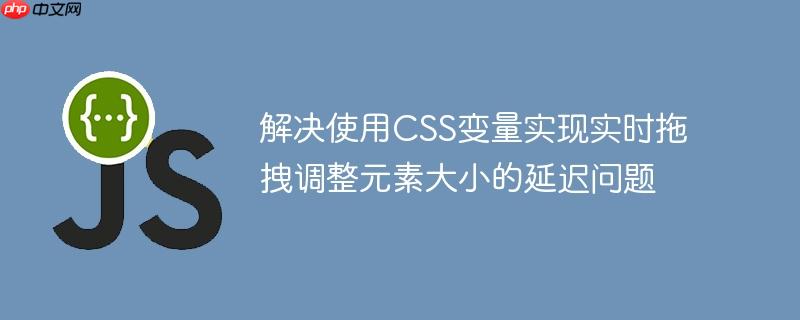
在现代web应用中,用户界面(ui)的可交互性是提升用户体验的关键。其中,通过鼠标拖拽调整侧边栏或面板大小是常见需求。开发者常利用css变量来管理这些动态尺寸,以实现更灵活的样式控制和组件联动。然而,在实际开发中,即使采用了事件节流(throttle)或防抖(debounce)等性能优化手段,用户在拖拽时仍可能遇到明显的延迟,导致元素大小无法实时跟随鼠标移动,严重影响用户感知。
一个典型的场景是,用户期望拖拽侧边栏边界时,侧边栏的宽度能立即更新。但实际效果却是,鼠标移动后,侧边栏会滞后一段时间才完成尺寸调整,这与用户对“实时”操作的预期相悖。开发者可能会误以为是CSS变量的性能问题,或事件处理逻辑的效率低下。
经过深入分析,此类延迟的根本原因往往并非CSS变量本身或事件处理函数的性能瓶颈,而是元素上存在的CSS transition(过渡)属性。transition属性旨在使CSS属性值的变化在指定时间内平滑过渡,而不是瞬间完成。这对于按钮悬停、面板展开/折叠等动画效果非常有用。
然而,当我们在拖拽过程中频繁修改元素的尺寸(例如,通过JavaScript更新CSS变量),如果元素上同时应用了transition属性,每次尺寸更新都会触发一个过渡动画。这意味着,每次鼠标移动导致尺寸变化时,浏览器会尝试在transition-duration指定的时间内逐步完成这个变化,而不是立即应用新的尺寸。这便产生了用户感知的延迟,因为元素在过渡期间看起来是滞后的。
例如,如果侧边栏有一个transition: width 0.5s ease;的样式,那么每次宽度改变都会在0.5秒内完成。在持续拖拽时,鼠标每移动一点,就会启动一个新的0.5秒过渡,导致界面无法实时响应。
立即学习“前端免费学习笔记(深入)”;
要解决这个问题,核心思路是在拖拽操作开始时暂时禁用元素的CSS过渡效果,确保尺寸变化能够立即生效;在拖拽操作结束后,再恢复过渡效果,以便其他动画(如面板折叠)能够正常运行。
以下是实现这一策略的步骤和示例代码:
准备HTML和CSS结构: 假设我们有一个侧边栏,其宽度由CSS变量--sidebarWidth控制。
<!DOCTYPE html>
<html lang="zh-CN">
<head>
<meta charset="UTF-8">
<meta name="viewport" content="width=device-width, initial-scale=1.0">
<title>实时拖拽调整面板大小</title>
<style>
:root {
--sidebarWidth: 250px; /* 初始侧边栏宽度 */
}
body {
margin: 0;
font-family: sans-serif;
display: flex;
height: 100vh;
overflow: hidden;
}
#sidebar {
width: var(--sidebarWidth);
background-color: #f0f0f0;
border-right: 1px solid #ccc;
box-sizing: border-box;
/* 初始的过渡效果,用于非拖拽时的动画,例如折叠 */
transition: width 0.5s ease-out;
}
#sidebar.no-transition {
transition: none !important; /* 拖拽时禁用过渡 */
}
#content {
flex-grow: 1;
padding: 20px;
background-color: #fff;
}
html {
cursor: auto; /* 默认光标 */
}
</style>
</head>
<body>
<div id="sidebar">
<h3>导航面板</h3>
<ul>
<li>菜单项 1</li>
<li>菜单项 2</li>
<li>菜单项 3</li>
</ul>
</div>
<div id="content">
<h1>主内容区域</h1>
<p>这里是页面的主要内容。</p>
</div>
<script src="https://ajax.googleapis.com/ajax/libs/jquery/3.5.1/jquery.min.js"></script>
<script src="script.js"></script>
</body>
</html>JavaScript实现拖拽逻辑: 我们将修改原始的JavaScript代码,在拖拽开始时添加一个no-transition类到侧边栏,并在拖拽结束时移除它。
// script.js
var mousedown = false;
var slide = false;
var relative = null;
var initialSidebarWidth = getComputedStyle(document.documentElement).getPropertyValue('--sidebarWidth');
// 获取侧边栏元素
const sidebar = $('#sidebar');
// 节流函数(保持不变,它有助于控制mousemove事件的触发频率,但不是解决延迟的根本)
const throttleFunction = (func, delay) => {
let prev = 0;
return (...args) => {
let now = new Date().getTime();
if (now - prev > delay) {
prev = now;
return func(...args);
}
}
};
$(window).on("mousedown", throttleFunction((event) => {
// 检查是否在侧边栏边缘附近点击
let cursorX = event.pageX;
let currentSidebarWidth = parseInt(getComputedStyle(document.documentElement).getPropertyValue('--sidebarWidth'));
let cursorMargin = 5; // 边缘检测容差
if (cursorX >= currentSidebarWidth - cursorMargin && cursorX <= currentSidebarWidth + cursorMargin) {
mousedown = true;
initialSidebarWidth = currentSidebarWidth; // 记录拖拽开始时的宽度
relative = cursorX; // 记录拖拽开始时的鼠标X坐标
sidebar.addClass('no-transition'); // 拖拽开始时禁用过渡
$("html").css('cursor', 'ew-resize'); // 改变光标样式
event.preventDefault(); // 阻止默认的文本选择等行为
}
}, 50));
$(window).on("mouseup", throttleFunction(() => {
if (mousedown) {
mousedown = false;
slide = false;
relative = null;
sidebar.removeClass('no-transition'); // 拖拽结束时恢复过渡
$("html").css('cursor', 'auto'); // 恢复光标样式
}
}, 50));
$(window).on('mousemove', throttleFunction((event) => {
let cursorX = event.pageX;
let currentSidebarWidth = parseInt(getComputedStyle(document.documentElement).getPropertyValue('--sidebarWidth'));
let cursorMargin = 5;
// 鼠标在边缘附近时改变光标
if (!mousedown && cursorX >= currentSidebarWidth - cursorMargin && cursorX <= currentSidebarWidth + cursorMargin) {
$("html").css('cursor', 'ew-resize');
} else if (!mousedown && $("html").css('cursor') === 'ew-resize') {
$("html").css('cursor', 'auto');
}
// 激活滑动模式并调整宽度
if (mousedown && relative !== null) {
// 计算新的宽度,并确保宽度不小于某个最小值(例如50px)
let newWidth = initialSidebarWidth + (cursorX - relative);
newWidth = Math.max(50, newWidth); // 设定最小宽度
document.documentElement.style.setProperty('--sidebarWidth', `${newWidth}px`);
}
}, 10)); // 适当降低mousemove的节流延迟,以提高响应性在上述代码中,关键的改动在于mousedown事件处理函数中,当检测到用户开始拖拽侧边栏边缘时,我们通过sidebar.addClass('no-transition');为侧边栏添加了一个CSS类。这个类在CSS中将transition属性设置为none !important;,从而强制禁用过渡效果。当mouseup事件发生时,sidebar.removeClass('no-transition');会移除这个类,使过渡效果恢复。
此外,为了更好的用户体验,mousemove事件的节流延迟可以适当降低(例如从100ms降低到10ms),以确保鼠标移动和元素尺寸更新之间的视觉同步更加紧密。
当在Web应用中实现实时拖拽调整元素大小的功能时,如果遇到明显的延迟,即使已经使用了事件节流,也应优先检查是否存在CSS transition属性。通过在拖拽操作期间动态禁用这些过渡效果,并在操作结束后恢复它们,可以有效解决延迟问题,为用户提供流畅、响应迅速的交互体验。理解并正确应用这一策略,是构建高性能、用户友好型Web界面的关键。
以上就是解决使用CSS变量实现实时拖拽调整元素大小的延迟问题的详细内容,更多请关注php中文网其它相关文章!

每个人都需要一台速度更快、更稳定的 PC。随着时间的推移,垃圾文件、旧注册表数据和不必要的后台进程会占用资源并降低性能。幸运的是,许多工具可以让 Windows 保持平稳运行。

Copyright 2014-2025 https://www.php.cn/ All Rights Reserved | php.cn | 湘ICP备2023035733号